#Turf Moor
Explore tagged Tumblr posts
Text

Thomas Street, Manchester.
#alaska#chic#ushanka#fur coat#Bunleyite#Turf Moor#regular#Sony#advocate#Manchester#street style#fashion#style#tote bag#drizzle#light rain#portrait#ootd#wiwt#NQ#Northern Quarter
29 notes
·
View notes
Text
PALMER🤩🤩!!!
The tap of the badge 😍
#that tap of the badge#cole palmer#chelsea fc#blueisthecolour#up the chels#football#premier league#Burnley vs Chelsea#turf moor#epl#cmon blues#cfc
3 notes
·
View notes
Text
Burnley FC : Andreas Hountondji, "Je n'ai pas peur... je suis dangereux"
Tout est bouclé depuis quelques jours, Andreas Hountondji est un nouveau joueur de Burnley FC. L’international béninois quitte la France pour l’Angleterre. Dans un long entretien, le nouvel attaquant de Burnley FC, a partagé son enthousiasme à l’idée de jouer pour son nouveau club. À 22 ans, le Guépard se dit prêt à relever les défis de la vie à Turf Moor et à contribuer au succès de…
#Ambition#Andréas Hountondji#Burnley FC#football anglais#intégration#jeunes joueurs#pression#Scott Parker#Supporteurs#trophées#Turf Moor
0 notes
Text
Match Review: Burnley 0-1 Manchester United
We're back! Well, sort of. 3 points, a rare win away, a clean sheet, a first start in 8 years for Jonny Evans, and a disallowed goal - all with a skeleton hodge-podge team. Decent.

Lets start with the stats:
Possession: Burnley 62% / United 38%
Shots: Burnley 12 / United 11
On target: Burnley 4 / United 4
Corners: Burnley 9 / United 5
Fouls: Burnley 6 / United 12
It wasn't a pretty win but United weren't set up for it to be glamourous. Emergency dictated that Jonny Evans started alongside Victor Lindelof at CB, with an unwell Sergio Reguilon playing through the pain at LB and Dalot at RB.

The makeshift defence wasn't perfect, and Burnley had a lovely break through the lines that hit the post, but United's lack of synergy and freshness made Vincent Kompany's side look sharper than they are in truth.
The midfield too: Bruno Fernandes out wide right (with Pellistri relegated back to the bench), Hannibal Mejbri handed a start, and McTominay/Casemiro also making up the midfield. Bruno's progressive play is high risk/high reward, so possession would be tricky there. Casemiro isn't Carrick, he's a bruiser, so he wants to win back and release, and then there's Hannibal - a high energy battler and presser - and McTominay, who is outrageously out of form and seemingly out of shits to give for the team. A sad sight, really.
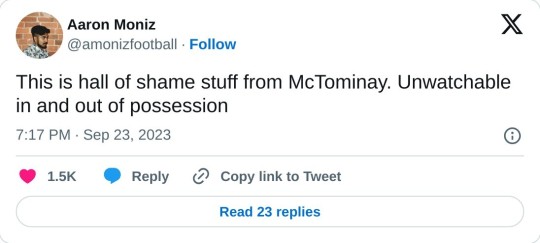
In what was a tough game for United away from home, down on luck, it could be seen as cruelty for Jonny Evans' headed goal to be denied by VAR for Rasmus Hojlund obstructing the keeper's view, but what better way to fight back than Jonny "Pirlo is a pussy" Evans pinging a ball upfield on his weak foot for Bruno to bury on the volley, bottom corner. Scenes.

You might need to click the tweet to see Bruno's goal but it's worth it. The little brother to the RVP/Rooney goal against Villa in in 2012/13.
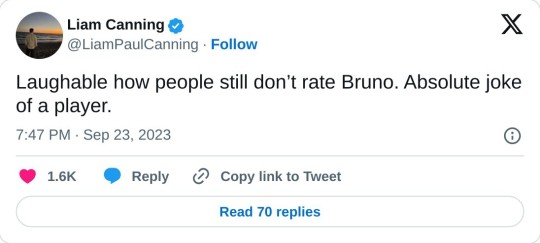
Bruno/Evans magic aside, it was a hard fought match by United and particular praise should go again to Hannibal Mejbri. The young Tunisian international was tireless in the middle pressing and jostling, but also quite tidy with the ball. Statman Dave was timely with the Hannibal stats post game:
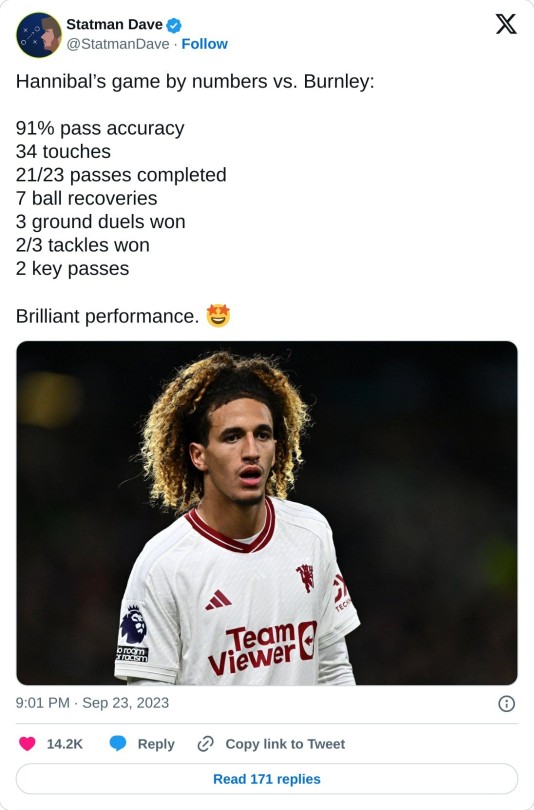
The youngster proved an astute rotation for Christian Eriksen who, like Juan Mata before him, is a genius level footballing IQ but whose physicality - through no fault of his own - means he can't be utilised as much as would be liked. Ten Hag was smart to recognise this quickly, rather than showing loyalty over suitability. In no world does Eriksen do what Mejbri did last night, and it probably costs United the win.
Beyond that there's not too much to analyse. Hojlund was unlucky not to slide in a low cross from Dalot, Rashford missed a late chance to tee up an open Casemiro, and Amrabat finally made his debut with a few minutes at the end - a similar story for the returning Raphael Varane. The only thing I didn't understand was Kompany's dress sense...
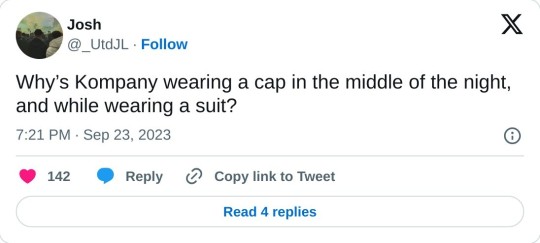
Ah well, a win's a win and United looked far more harmonious and relaxed after the result than we've seen in a long time. Lets hope our favourable run of games now can become a proper run of form, especially with so many home fixtures. Lets also hope Jonny Evans, the true red, maintains this level of form just in case we need him again.
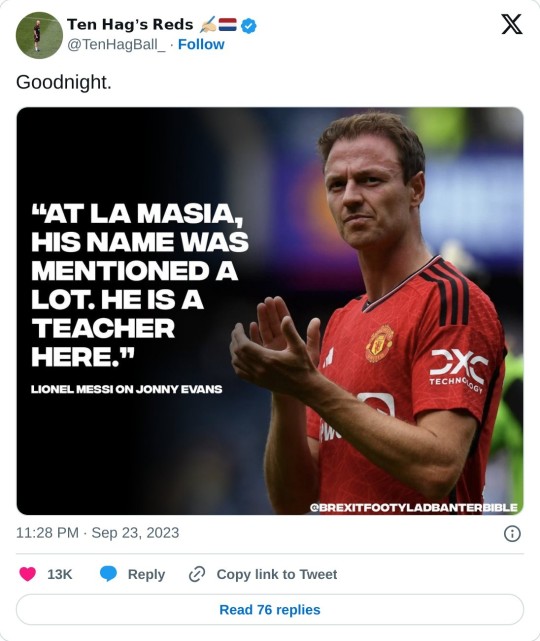
#manchester united#man u#man united#man utd#manchester reds#erik ten hag#casemiro#christian eriksen#marcus rashford#jonny evans#sergio reguilon#hannibal mejbri#scott mctominay#hall of shame#rasmus hojlund#turf moor#burnley fc#sofian amrabat#diogo dalot#bruno fernandes#wonder goal#what a goal
1 note
·
View note
Text

Oh bon sang OUAAAAIS....
#Everton#Liverpool#Toffies#Goodison Park#Burnley#Turf Moore#Chelsea#Stamford Bridge#Newcastle#Saint James Park#Nottingham#Nottingham Forest
5 notes
·
View notes
Text
Part Two
Pretty Little Thing
Tags & Warnings: Chicago au, non-canon events, mafia au, Smoke and Stack are in a gang, Remmick is in an Irish mafia gang, alcohol, age gaps, Everyone is up north, long fanfic, eventual smut, dub-con, Black Female Reader, Reader is 22, MDI
Synopsis: At the twins new night club in Chicago, you give an opening performance and among the crowd of onlookers a certain Irish man from the other side of the southside eyes linger a little too long on you.
A/N: fyi 13 dollars is like 200-300 something dollars in the 1930s!!!
Word Count: 2k
Reblogs, Likes and Comments are appreciated
“How much do I owe you?” Your tiny fear stricken voice squeaks.
“Thirteen dollars and fifty cents.”
Your mouth gaps at the way he casually says the price as if the smuggled Canadian Whisky doesn’t cost an arm and a leg.
You nervously laugh. “But I’ve only got fifty cents to my name, sir!”
Remmick rises from the red couch, hands buried deep in his black slacks. “That’s an easy fix.”
Hearing enough, Smoke intrudes in your one on one conversation with the strange man who overflows with a sense of danger around him. Dangerously close to Remmick eye to eye, blocking you from the other man’s view. “Or we can arrange shit right here, right now and leave my little cousin out of this,” He says. “After all you came here for business, not my family.” His eyes gleam with venom.
As much as you, everyone on the southside ran by the twins, and even Stack himself feared Smoke at times like this, Remmick on the other hand is unfazed. The Irish man almost looks bored as your older cousin looms over him, ready to make bullets rain.
The younger twin is quick at his brother’s side. “Easy, Smoke.” He puts a calming hand on the older twin’s tensed shoulder.
“I don’t like repeating myself, Moore. I want the little birdie to pay me what she owes me.” He lazily walks to the bar near you.
Too close for your liking. It makes your stomach flip and stir the booze you drank earlier.
He pours himself a drink and gulps it all down without flinching at the bitter, throat burning poison as if it’s water. “Not to mention you’re in no position to be callin’ shots. Wasn’t it your boys caught causing trouble on my turf?” He playfully tilts his head like a fox. A mocking smile dances on his handsome face.
Smoke and Stack look like someone took a sharp butcher knife and chopped their ego and pride to pieces as shame rises on their faces. They hate being reminded of the bloody turf dispute that occurred a few weeks ago on the behalf of their own men. Especially since it puts them at the mercy of the other gang, like a dog with its tail tucked between its legs.
“Don’t rub it in,” Stack says, annoyed.
Remmick throws his hands up at his shoulders. Two shiny golden signet rings decorate each index finger. “No, no! Just a friendly little reminder!”
If it wasn’t for your mere presence in the room and now tangled in their web of business, Smoke would’ve shot the cocky bastard right where he stands, though he knows it wouldn’t do much harm. Silver bullets only do so much damage to a freak of nature like Remmick.
The longer you stay in the room with these three men the more the air gets deadlier and toxic to inhale. So you force yourself to speak up, wanting out now. “Listen, sir,” you say and their eyes all flick at you. “I don’t have all the money right now, but I’ll have it for you in a week or two, so–”
“No, you see that won’t do, Sweetheart.” He shakes his head.
“What? Why not?”
“Cause I need my dough now and on my terms.”
Smoke’s hands are quick to aim a pistol at Remmick. Wild Flames burn and dance behind his cinnamon brown eyes. “Fuck that. Fuck the turfs. I don’t give a shit bout that no more. I ain’t giving up my flesh and blood to the enemy, I know what you’re playing at, fool.” Smoke is a man of family and he would kill anyone posing a threat to his kin.
Your heart hitches in your throat seeing the sudden flash of a gun. Whenever situations involving the twin’s crew hit the fan you always made sure to never be around to see it unravel, but now you’re caught between the crossfire. And you don’t like that. You don’t want to see blood spill.
“S-Stack, he’s not gonna shoot him, is he?” You stammer, eyes anxiously bouncing between Remmick and Smoke.
Your question goes unanswered and unheard as Stack pulls his guns out as well. They both surround the Irish man, faces made of stone and steel. But Remmick remains unmoved, casually leaning on the bar’s table. In your eyes he’s got a death wish the way he still manages to smile in their faces.
“Y/n, you get on outta the way,” Smoke begins.
“We finna blow this motherfucka to pieces,” Stacks says, finishing the sentence.
No hesitation, in a flash you're away from the bar and far behind the twins. You know better than to disobey them.
“So, it’s a war you want?”
His words make the twins' fingers waver on the triggers. It wouldn’t be the first time they witnessed a war in the underworld of Chicago. When Smoke and Stack first arrived in the Windy city and got sucked into the hellish world of gangs and violence they saw it all first hand. How innocent life fell victim to unjust muruder all because a man controlling a group of men couldn’t get along with another man leading his own group of men from different sides of the city. The twins both swore they would never let a turf war break out on their watch as long as they’re in charge. Yet here they are, guns aimed at a man with the power to crush their community with the lift of a finger.
Remmick knows it and the twins know too, this won’t end well. No, it will end in cold blood.
Smoke shoots his pistol. The gunshot rings in your ears, making your body jolt, covering your ears. When your eyes open you expect to see the white man drowning in his own blood on the black marble floor. Instead, glass is sprinkled across the floor and bar table. Tiny shards mix together with whisky from the bottle you opened. You blink, surprised and a little traumatized now.
“Fuck!” Smoke growls, slinging the pistol somewhere on the floor. He paces and pinches the bridge of his nose. “We can’t afford no damn war.”
Stack sighs. Relief floods his features and he retreats the gun back in his hip holster. “Damn, Smoke, why you gotta go making messes and shit.”
The backroom’s door slams open. Sammy and Bo rush into the room.
“What the hell’s going on back here?” Bo demands. He’s alert and slightly confused with a gun loaded in his hand. His face drops seeing the spilled liquor mixed with glass. “The fuck ya’ll got going on back here?”
“Nothin’, just a deal gone south!” Stack shines a smile at Bo and Sammy.
Sammy and Bo scramble from the room back to the front and the tense aura pours into the room again. You shift awkwardly in your spot, waiting and wondering what’s next.
“What’s the terms, Irishman?” Smoke exhales, eyes burning with fury tangled with defeat.
A sinister smile pulls at Remmick’s lips.
—--------------
At the end of the night you ended up with an invisible debt stamped on your body that only you, the twins and Remmick knew about. In hindsight it didn’t seem horrible and in fact you thought nothing of it. All you have to do is sing in the Irish man’s nightclub in his side of town–easy peasy. Well, at least that’s how you felt until now.
The Irish nightclub on the other side of town is nothing like the one you performed in on your side town. Here, the eyes of people who look nothing like you stare. It doesn’t even take a child to understand the look in their eyes as it’s crystal clear. Some look at you with pure hatred like you’re the spawn of satan while others look at you like you’re some lost puppy in a world of danger. Regardless, all of their eyes make your skin crawl uncomfortably. You wanna go home back where people are welcoming and look exactly like you. If this is a punishment from the Irish man he sure did a splendid job because you hate every bit of this.
In the women’s dressing room, tears burn in your eyes, begging to fall, but you refuse to let them. Whatever sick gag this man, Remmick is pulling, you won’t let get to you. No, at least not in his very domain.
“You okay, honey?” A soft voice says nearby.
You look to find empty chairs in front of the lit up mirrors with multiple glowy bulbs. Seeing no one in any of the chairs next to you makes you think you’re already going insane until the voice comes again.
“I’m right here, hun.”
There behind you in one of the pale pink couches, is an older lady with chocolate brown locks neatly styled. Her face is battered in perfect makeup which compliments her features well.
“Oh, hello there…” You voice trails off. “Didn’t see y’a there on the way in here.”
“I actually just came in,” She admits. In seconds the older woman occupies a seat next to you. “Don’t worry, honey, no one here will hurt you.”
Your brow cocks at her odd sincerity towards you, a complete stranger. Maybe she’s one of the ones who feel bad for your being here. It nearly makes you roll your eyes at her. Of course you somewhat do appreciate it, but it still rubs you the wrong way.
The soft smile stops reaching her eyes as she gazes at you. “Why you looking at me like that?”
You blink, not knowing what to say. Being outright rude wouldn’t cut it even though what you’d say isn’t meant that way. But you’re positive she would probably take it that way, wounding her pride. Last thing you need is an enemy here in the enemy's home. You just stare, lost for words.
She sighs, fingers playing with the pearls draped around her neck. “It’s me, Mary.”
It doesn’t ring any bells as confusion twists your face in knots. “Who?” Your eyes squint at her.
She sighs again, astonished. “Stacks old lady, Mary! Wait, has he never mentioned me?”
Relief fills you at the mention of Stack. Meaning they haven’t completely thrown you to the sharks afterall. Her guess is correct. Stack nor Smoke in fact never mentioned a white passing black woman ever, or at least not to you. She explains the twins sent her to ensure your safety while you’re paying off your debt to Remmick until an urgent knock at the door ends the small safe space you built with Mary in a short span of time. It was time for your performance, in other words humiliation for all non kin skin folk to behold.
A tall man leads you to your destination. As you follow behind you notice he isn’t taking you to the main stage, but somewhere else. Through halls that turn, twist and a set of stairs, he finally yields at a door.
He knocks and says, “she’s here, boss.”
Boss? He definitely means that cocky, evil, pale man Remmick.
The door clicks open swiftly to a room filled with dimly lit soft golden lights. Similarly to the twin’s backroom, Red and black paints the space. Centered in the room is a mini stage inches away from the only sitting area of a round small table encircled by a spiral obsidian leather couch. There is no bar and there are no other areas. Only the stage and couch as if created for the sole purpose of a small audience. Your throat dries and heart trembles as the man who guided you here leaves. A clicking sound signals the door is sealed off from the public and makes your dread awfully cold, nailing goosebumps over your exposed brown skin.
“Don’t be shy, Sweetheart. Come on in,” a deep familiar voice says, hidden behind the cherry red silk curtains around the circular couch.
Perform for him. Get the money. Pay him. Never see him again. You remind yourself, dragging your sharp heels on the extravagant carpeted floor.
“Hurry now. I don’t like to be left waiting.” The tone of his voice is darkly commanding yet light. As if he doesn’t wish to invoke too much fear in you.
You make your way on the stage and reside at its center. Protectively your arms wrap around your frame, trying to cover your overly exposed skin. Though it doesn’t matter anyways with what he prepared for you tonight to wear. An embezzled shiny snow bra with baby blue beads merely covers your top and high waist sequin panties matching your top hug the bottom of your body.
His hungry gaze roams every inch of your body, stringing a chill shiver through you. The beautiful chandelier hung above the couch, highlights his alluring features. Today unlike yesterday, he dons a dark striped vest, white rolled sleeves and black slacks.
“Well, what’re you waiting for? Give me a show, doll.” His Irish accent is thicker than yesterday.
Sensual music begins to flood the room as Remmick intensely watches, itching to do more than simply watch. No, he told himself he would be patient with you. Take his time peeling every layer you had to offer. Even if you act up or invoke him to punish you, he would find a way around it. He’s had plenty of dolls. Some boring, others fun. You, however, seem like fun all around. A cheeky little mouth, a tinge sprinkle of naivety to the cruel world around her and a certain pureness. Not the type of purity in which the apple is untouched, no, the type that is inexperienced with a real man like him in every aspect.
It’s true. You’ve only ever had one man you loved in your life and gave to him your virginity at the ripe age of twenty. People say it’s important who you give it to and afterwards you’re tainted. Or at least that’s what some odd church folk say. You didn’t care that he was the one who got it nor was it regretful. What you regretted was being naive to the point of stupidity for that man. After him you swore to yourself to never love a man that way again. But of course this Irish man doesn’t know that. Yet.
Your body slowly follows the waves of the rhythm, like riding a sea wave at the beach. His eyes eat every movement you make on the stage. Clouds of cigar smoke float around him, adding to his ominous presence. When the music stops, your heart drums in your ears and the saliva you gulp barely soothes your dry throat. The music played for so long you lost track of time and dancing felt like forever.
“That was satisfying,” He lowly hums. Remmick leans back deep in the leather cushion and pats his lap. “Won’tcha join me over here, Sweetheart.”
You freeze on stage. Eyes blinking frantically. “I don’t think I will, Mr. Remmick. That wasn’t part of our deal. I’m here to perform on a stage, not entertain in such a way,” You state, finality in every word.
He shifts on the couch, lips in a small smile that doesn’t reach his eyes. “Oh, really?” The tone of his voice is unreadable.
“Yes, now if you’ll excuse me, I’ll be taking my leave now.” Off the stage and at the exit, you twist the handle. The knob fails to budge flaring sirens in your brain. “Let me out of here!”
He takes one last drag of the cigar before digging it in a crystalline ashtray. Idly he stands off the couch and saunters to you. The way Remmick moves is predatory like a calm animal who knows its prey isn’t going anywhere. Time appears to slow as he looms closer and with each passing millisecond every ounce of icy confidence melts away until his tall frame hovers you. Mini goosebumps prickle at your skin as his palm slams on the door above your head. Your heart screams in your chest as terror paralyzes you.
“What’s the matter? I thought you were leaving, Sweetheart?” The light once ringing in his voice is no more, instead it’s lower and cold. “Hmm? You’ve nothing to say?” His head tilts, almost mockingly.
You don’t say anything. Can’t say anything because your mind and body won’t allow it. In one swift blur you’re thrown over his firm shoulder then on the black leather couch. He pulls at his collar, popping a few buttons. “It seems no one has taught you any lesson about authority.” Remmick runs a hand through brunette locks. “Allow me to be the first, Sweetheart.”
#remmick x reader#remmick#remmick x you#jack o'connell#remmick smut#remmick x female reader#remmick x black!reader#sinners#sinners 2025#sinners au#sinners fanfiction#female reader#sinners fandom#black reader#black female reader#black female writers
224 notes
·
View notes
Text
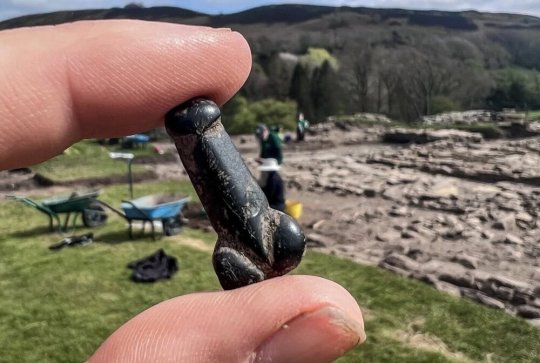
Roman Phallus Pendant Unearthed at Vindolanda
Excavations at Vindolanda near Hadrian’s Wall have unearthed a miniature phallus pendant.
Vindolanda, meaning “white field” or “white moor,” was a Roman auxiliary fort guarding the Stanegate road just south of Hadrian’s Wall.
Between AD 85 and AD 370, no fewer than nine timber and stone forts were built on the site, making Vindolanda one of Britain’s most complex archaeological sites and a time capsule of Roman military life on the frontier.
Vindolanda remains an active archaeological site (celebrating their 55th anniversary of being the Vindolanda Charitable Trust), where excavations have uncovered thousands of remarkably preserved shoes, textiles, wooden artefacts, and the famous Vindolanda tablets – the oldest surviving written documents from Roman Britain.
In the latest season of excavations, archaeologists have unearthed a miniature phallus pendant made from jet in the remains of a 4th century wall.
The Roman’s believed that the phallus was the embodiment of the masculine generative power and provided protection, fertility, and good fortune. Phallic imagery appears throughout the Roman world—in sculptures, mosaics, frescoes, and portable items such as pendants and bullae.
Along the corridor of Hadrian’s Wall alone, there are 59 known phalli in various forms, whether incised, relief, or sculpture depictions that are grouped into nine morphological traits: the rocket, the hammer, the kinky-winky, the splitcock, the pointer, the double-dong, running hard, the beast, and the lucky dip.
The miniature phallus pendant follows on from a 2024 discovery at Vindolanda where archaeologists discovered a phallus symbol carved into a stone slab.
The 2025 excavations are a continuation of a research project from 2024 to 2028 that focuses on the last remaining turfed area within the boundaries of the final stone fort constructed at Vindolanda.
By Mark Milligan.
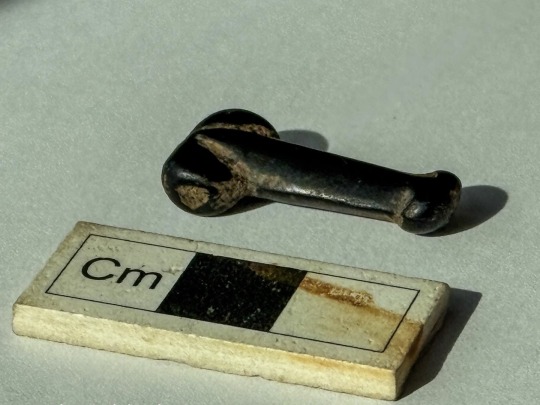
#Roman Phallus Pendant Unearthed at Vindolanda#Roman auxiliary fort#Hadrian’s Wall#ancient jewelry#ancient artifacts#archeology#history#history news#ancient history#ancient culture#ancient civilizations#roman history#roman empire#roman art
76 notes
·
View notes
Note
Another Killie question! Has he ever ridden in the US, particularly in any of the graded stakes dirt races?
(In reference to Killie the Jockey OC)
Yes! He was bred for them.
for those who don’t know, the ancient and insane sport of horse racing is practiced differently around the world. Some of those differences are based on track surface. Track conditions, aka the Going, are when the track is impacted by weather. This is where terms like “slow going” and “hard going” come from.
Europe primarily races on turf, which is grass. The USA usually races on dirt. It’s more dangerous but makes for a fast hard race.
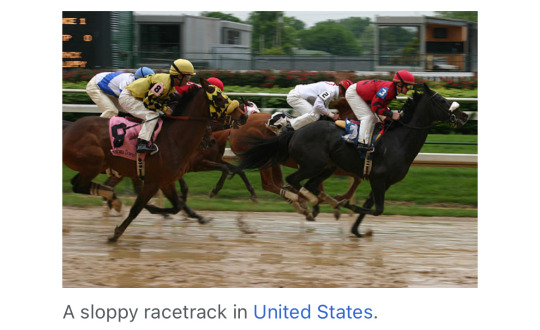
Americans like fast, hard, fierce flat racing on even, consistent dirt surfaces, for short distances and deliriously large purses; Irish and British horse racing is in love with long medieval-looking steeplechasing in the cold rain on grass, over varied terrain, for the prize of a bag of crisps. As a result there are different strategies. American races favour sprinting and consistency of performance. UK fans claim there’s more jockey strategy, stamina and overall complexity in their races.
A “graded stakes” race is a high-quality race with a high purse, high standards of performance, and restricted entry. The Kentucky Derby and Breeder’s Cup races are Grade 1.
It’s quite reasonable for jockeys to compete internationally. This exciting picture of Mountain Bear actually shows an Irish horse and jockey attending Keeneland in Kentucky, USA. Americans are ferociously devoted to low racing weights for jockeys; in the Kentucky Derby, the jockey and all their gear must weigh out at 126 lbs (jockey, equipment, saddle and all.) but America also famously offers super-fucking-high purses, so everyone sends their smallest warriors ambitious flat jockeys from around the world will often compete in America, or even move there permanently.
Killie is ambitious and competitive, and was bred and trained for the flat. He weighs in comfortably for the American scene. His career tracks similarly to Ryan Moore (UK) and Oisín Murphy (IRE), who have both had success in the USA.
But it would only be for a few specific races, planned by his trainer in advance. He has a significant size advantage, and can manage the different strategy; but to the distress of his parents, he’s a steeplechaser at heart.
I can imagine him scooping up a bunch of Breeder’s Cup trophies, but not the Kentucky Derby.
94 notes
·
View notes
Note
Greetings!
Any related words to "garden" you might know and would like to share? Thank you.
Hi! Here are some related words for you :)
Garden—a plot of ground where herbs, fruits, flowers, or vegetables are cultivated
Allotment - a small piece of ground in or just outside a town that a person rents for growing vegetables, fruits, or flowers
Arboretum - a large garden where many types of tree are grown, for people to look at and to be studied for scientific purposes
Backyard - a space at the back of a house, usually surrounded by a fence, and covered with grass
Campo - a grassland plain in South America with scattered perennial herbs
Demesne - landed property; estate
Estate - farm, plantation; also: vineyard
Field - an area of cleared enclosed land used for cultivation or pasture
Finca - a rural property, ranch, or farm in Spain or Spanish America
Garth - a small yard or enclosure; close
Grassland - an ecological community in which the characteristic plants are grasses
Greenhouse - a usually permanent climate-controlled structure enclosed (as by glass or multiple layers of plastic) and used usually year-round for the cultivation or protection of tender plants
Greensward - turf that is green with growing grass
Ground - an area used for a particular purpose
Homestead - a tract of land acquired from U.S. public lands by filing a record and living on and cultivating the tract
Hothouse - a greenhouse maintained at a high temperature especially for the culture of tropical plants
Lawn - ground (as around a house or in a garden or park) that is covered with grass and is kept mowed
Lea - grassland, pasture
Meadow - land that is covered or mostly covered with grass
Moor - a boggy area; especially: one that is peaty and dominated by grasses and sedges
Parcel - a tract or plot of land
Park - a piece of ground in or near a city or town kept for ornament and recreation
Pasture - land or a plot of land used for grazing; pastureland; pasturage
Plot - a small area of planted ground
Prairie - a tract of grassland
Savanna - a temperate grassland with scattered trees (such as oaks)
Terrain - a piece of land; ground
Tract - a defined area of land
Turf - grass
Veld - or Veldt; a grassland especially of southern Africa usually with scattered shrubs or trees
Yard - the grounds immediately surrounding a house that are usually covered with grass
Hope this helps! Do tag me, or send me a link to your writing if it does. I'd love to read your work.
Sources: 1 2 ⚜ More: Word Lists
#anonymous#word list#garden#writeblr#langblr#linguistics#words#literature#writing prompt#spilled ink#dark academia#writing reference#poets on tumblr#poetry#writers on tumblr#nature#creative writing#fiction#writing inspiration#writing inspo#writing ideas#writing resources
104 notes
·
View notes
Text
Moorland Research Notes
I usually let these sit in my drafts because they're kinda messy, but no one actually knows anything about moorland, including myself shortly before starting this deep dive. So I'm just going to post this in the hopes that it's useful in some way
This post is about moorland in the UK, I have not done any research into moorland in other places, and then I focused more specifically on lowland heath.
Feel free to use this information for anything you so desire, and check out the sources I put at the bottom of this list if you'd like to learn more. I really hope this helps out WindClan Fans in particular
I do plan to condense what I've learned and chosen into a "Welcome to BB!WindClan!" type post at some point, but this is a REALLY broad post on what moorland is.
What is moorland?
Moorland is a broad term that lumps together several completely unique biomes, most of which are partially or completely reliant on the management of human beings. They are defined by low-growing flora and acidic soils, which makes them difficult for non-specialist plants to grow in.
These can be sorted further into upland or lowland, dry or wet.
Because many types of moorland are dominated by heathers, they are also called heathlands. Though the terms Moor and Heath are sometimes used interchangeably (and this is where a lot of confusion comes from), usually, Moor refers to upland/wet, and Heath refers to lowland/dry.
I have to stress a that LOT of the confusion is coming from this. Heather will grow in both, and the terms get used interchangeably, but an upland/wet moor is FUNDAMENTALLY different from a lowland/dry heath, down to the very soil.
Most specialists will open up an explanation by defining how they're using the Moor/Heath distinction, and will stick to those terms, but just keep in mind that in casual language, ALL of these biomes get called moors, and places without any heather will get called heath.
They can also touch. There are locations where upland moor slopes into lowland heath, or upland heath kisses lowland moor, and there can be very special species that exist in the transitional space between these areas. This too is yuri.
It is not a prairie. It is not a savanna. Please for the love of god stop portraying moorland as prairies and savannas
lots of purple. why he ourple? heathers and purple moorgrass.
Common heather is also called ling, flowery bell heathers are sometimes called erica, and gorse can be called whin or furze
Maritime heath, dune heath, blanket bog, upland moor, transitional upland heath... these are all frequently lumped under the same term even though they are very different.
How are moorlands managed?
Above 700 meters of altitude and in harsh weather conditions, you get montane heath. Near coastlines, you can find maritime heath. These are the only two that are completely "natural" and require no human management.
In wet moors, the elements will beat the vegetation down into peat. Above the peat is turf, the top layer which grows the visible flora. Peat = below, Turf = above. Peat has historically been used as a fuel, and if that bottom layer catches fire, IT IS DISASTROUS.
Because of this, most upland moors (which are usually wet and PACKED with peat) are managed primarily through grazing. There are even breeds of sheep and cattle who have been specially bred to thrive in upland moors-- such as the iconic highland cow. (Though overgrazing can be a problem, too.)
Sheep are used to graze back the heather (sometimes called ling), and in good modern practice, goats are brought out along with the flock to eat pioneering shrubs and saplings. Pigs are also used to control bracken and combat ex-pine plantations with scattered needles, because of their ability to churn soil.
However, controlled burns are still done in some circumstances and when required (LIKE BEFORE A HEATWAVE). Because of the serious danger, it's considered inferior to good grazing management. It's done carefully, in controlled patches, both to not set the underlayer of peat on fire and to make sure there is differently-aged patches of flora in one area to support different species of animals.
If peat catches on fire, it will burn for days or weeks... and can even smoulder underground after you THINK it's been put out.
In DRY LOWland heath, proper burning is common. Gorse and heather grows strong, woody, and flammable, and the thin layer of peat below can combine to devastating results when a wildfire does eventually break out. Large swaths of dry heather and gorse is an ecological powderkeg, even if it was only growing on mineral soil.
Worse, the older heather gets, the woodier it becomes. Woody heather can cause high-temperature fires that absolutely devastates new growth, leading to a slower recovery and causing a controlled burn to become uncontrolled real fast.
Burns are typically conducted in winter, when it's cold, and grazing animals are deployed in summer.
Cutting is also important in lowland management, literally cutting out squares of turf to expose the ground. This is good for mason bees, specifically.
Moorland. Is. Flammable. Fire risk = HIGH.
If you do not manage the moorland, the moorland will manage YOU. with FIRE.
Do NOT set the peat layer on fire. Whatever you do, do NOT let the peat get set on fire. PEAT FIRE BAD.
The controlled burning of moorland is "swaling", or a "muirburn."
Pigs and goats have special abilities when used in grazing management
Pigs are a tactical nuke
Sheep will graze heather a lot harder than cattle, causing grassy "sward". They should be kept away from it in winter.
MOORLAND IS NOT GRASSLAND. Sward BAD.
Cattle will graze moorgrass a lot harder than sheep and bite back any sheep-induced sward, but trample the soil with their heavy hooves.
Bones tell me about the funny cat environments
Victoria Holmes (the original writer of Warrior Cats, for those who have just walked in, still in your bathrobe and perhaps comically eating some sort of breakfast bagel, on a cat giving a detailed ecological lecture to a bunch of other cats) has spoken about how she based the environment of the Forest Territories on New Forest, Hampshire UK.
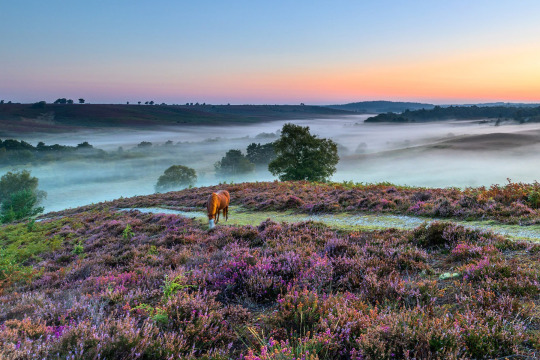
[ID: New Forest's heathland on a misty morning. It's dominated by common heather with a few sparse trees, and a New Forest Pony grazing alone.]
That means that WindClan's moor was a lowland heath, characterized by sandy soils with excellent drainage. This is consistent with the thin layer of peat, deeper layers of sandy soil and clay (as encountered by tunnelers), and lush vegetation that's seen in DOTC and Tallstar's Revenge.
If that's not enough evidence, it's also described after its destruction in these terms;

New Forest boasts some of the widest swaths of well-managed lowland heath in the entire UK. It's been managed collectively for hundreds of years, and exists in tandem with bogs and old-growth forest for miles. The heath is just as important as the trees, here!
In TNP, the forest is tragically bulldozed to create suburbs. While they were at it, they also bulldozed the geography of Great Britain because, suddenly, there is a MOUNTAIN in Southeastern England; a region notoriously flatter than the Onceler's ass
So once the Clan cats get to the Lake territories, we could be dealing with a completely different biome. They might have gone from dry, lowland heath, to wet, upland moor.
However, descriptions of the new territory are scarce, to put it lightly. In spite of the Lake Territory being the setting for the past 20 years, WindClan's land is rarely shown. When we do get a glimpse of it, like in Crowfeather's Trial, we only get told about the presence of certain species such as gorse. Because of there being no tunneling, we don't know what's exactly below the surface, either.
Occasionally though we are made aware of the presence of "moorgrass" (possibly Molinia Caerulea) and the smell of peat, pointing towards it probably being upland moor. The bigger question is actually where all the sheep are? There should be a lot of sheep here, but instead, there only seems to be horses.
Aaaaand lastly before I close out on canon material, Lungwort.
Lungwort is a herb that becomes a plot device in A Vision of Shadows. ShadowClan becomes sick with a variant of greencough, and it is said that Lungwort would be its only cure. However, it "only grows in WindClan" and the leader, Onestar, has refused to let them have this medicine.
But lungwort doesn't grow on moorland. ESPECIALLY not wet, upland moor, which we might maybe possibly be dealing with now.
Lungwort is a FOREST plant, it needs the absolute opposite conditions of a moorland. It requires moist but well-drained ground, FERTILE soil, and full or partial shade. There's no way that WindClan has it and ShadowClan doesn't, OR its neighbor ThunderClan, in the WOODS, who Onestar has no power over.
It would also poison a cat but honestly 75% of the plants they use in canon would also do that, so, whatever.
What they SHOULD have gone for is great mullein which prefers full sun and well-drained soils, so it could feasibly be found best in some parts of WindClan, regardless of which sort of moor or heath primarily makes up their territory.
What sorts of plants are found in moorlands?
In moorlands, you'll find plants that can withstand poor soil quality and full sun. In upland moors, they also have to be hardy in frequent heavy rains and high winds. Because it has conditions that so few plants are able to handle, moorland is chock-full of specialists and unique species that aren't found anywhere else!
Historically, moorland could not be used for agriculture exactly because of this. With the invention of artificial fertilizers and introduction of (invasive) pines from America, moorland is under serious threat. Even if it's just next to a pine plantation, the trees will attempt to spread.
COMMON HEATHER, also called Ling, is the big bad boy associated with most moorland, and used for a bajillion different things. First of all, it was used in construction for thatching. Second of all, it can be used as a yellow dye, especially on wool. Third, honey made from heather pollen is as thick as jelly. It's found on all sorts of moorland, and is an extremely hardy species.
BELL HEATHER, sometimes called Erica, is more commonly associated with lowland heaths. It's one of the best flowers for pollinators in the entire world, and attracts tons of insects.
GORSE, also called Whin or Furze, smells overwhelmingly like coconut. It is also covered in wicked thorns. It's highly flammable and can burn ridiculously hot, making it excellent to collect as kindle.
PURPLE MOORGRASS is associated with upland moor, but will grow basically anywhere nothing else could. It's scary hardy, surviving in acidic soil down to a PH of 2 (THAT IS THE SAME LEVEL AS YOUR STOMACH JUICE), and can grow as tall as 4 feet (and even taller, apparently, next to its bestie girls heather and gorse).
In heath, tormentil, milkwort, and heath bedstraw are indicator herbs, and wavy hair-grass, bristle bent, and vernal grasses are found here and there.
PLEASE remember that moorland is not grassland. When grasses go from sparse to common, it's a very bad sign. It means the soil is losing its acidity, and converting into a different biome.
Bramble, bracken, nettles, perennial ryegrass, and broadleaf plantain are some of the species that can indicate that a heath is becoming a grassland. A few patches or examples are fine, but if they're eating into the gorse/heather/moorgrass, it's time to call in some management.
There's also the fascinating, parasitic plant called dodder. Dodder likes to twirl around heather before suffocating it to death. Cool plant! I don't know where else to mention dodder. I just think it's neat.
Threats to Moorland
I mentioned the problems in passing through this whole post, but to restate, these are some of the major problems that moorland faces.
AFFORESTATION: When trees are added.

[ID: A sitka spruce plantation on upland moor in Scotland, followed by a clip of Markiplier who condemns it in no uncertain terms.]
American pines, such as the douglas fir and sitka spruce don't belong here. These are commercial plantations and they exist to make money, but are touted as "eco friendly" because uneducated rubes think 1 Tree = 1 Ecology Point. They provide diddly or squat to native wildlife, destroy valuable moorland which can negatively impact carbon capture, and let fools pat themselves on the back for doing nothing but put government money into a logging company's pocket.
(there are also only 3 native conifers to Great Britain-- the scotch pine, the common juniper, and the yew. All others are introduced.)
But even worse than being a wooden blight, these are wooden blights that spread. If there's a plantation nearby, it WILL begin to encroach on the surrounding moorland, and the traditional sheep and cattle will not eat the saplings. GOATS are being added to herds in modern grazing management to combat this new problem.
The native birches (silver and downy) plus the scotch pine will also move in when moorland is not managed! They are pioneer species, which success the moor into secondary woodland.
OVERBURNING: When moorland is burned too much.
Even if you don't set the peat on fire and cause an even bigger problem, too much burning is bad for the biome as well. This is often done to serve hunters, who want to perpetually keep common heather in the youngest state possible to support grouse populations... and grouse populations alone.
Properly managed moorland will be burned in sections, NOT all at once, so that there's a healthy mix of plants in different ages to provide shelter and food to the animals that live in the environment. Too much burning will decimate the insect population, and prevent peat buildup.
("Hold on Elder Bones, why is peat good?" Carbon capture and soil acidity! It's super efficient at combating global warming, and peaty soils will prevent the moor from quickly succeeding into a grassland.)
NUTRIENT ENRICHMENT: De-acidifying the soil and making the soil welcoming to other species
Specifically from dog and horse droppings, but also from the addition of fertilizers. The biggest thing that can be a problem here is how conservationists try to balance public access to these spaces with the "recreation pressure" from having too many visitors.
SOURCES
I have had to do SO MUCH READING. OH my god, this was not easy research, please appreciate this big, beautiful list of resources I am giving to you
GREAT BRITISH LIFE: A really good intro to heathland (This article was written by Katie Piercy from the Cheshire Wildlife Trust)
WILDLIFE TRUST: Heathland and Moorland, Moorland, Lowland Heath, Cheshire Heath, Bell Heather, The Roaches
BUGLIFE: Upland heath as it relates to insect populations (website contains insect-centric guides to many unique UK biomes)
NEW FOREST: Heathland information and history
NATIONAL TRUST: Bickerton Hill and the Restoration Work
WIKIPEDIA: The Roaches, Yorkshire Dales, Heath, Moorland (listen kids, wikipedia is always a great place to start. Just make sure to double-check the claims you see there.)
COUNTRY LIFE: A flowery article that describes the North York Moors (this one's just really pleasant!)
AN ACTUAL LOWLAND HEATH ECOLOGIST: Dr. Sophie Lake's Presentation for the NPMS (This is the most detailed and proper source on this list, if you want to learn some serious info, PLEASE check this one out)
235 notes
·
View notes
Note
Hi there! I’m just finishing Wuthering Heights and I need to clear my brain before starting Tenant of Wildfell Hall. To that end:
What the hell did I just read?
We all agree that Cathy #1 haunted Heathcliff to death because she was tired of waiting for him/fulfilling her dying injunction that she’d take him with her, correct?
What does the symbolism of Heathcliff’s, Cathy’s, and Edgar’s graves all three isolated and forever together mean? Is Edgar in his heaven, or is he doomed to sit by and watch Heathcliff and Cathy cavort over the moor as ghosts?
As a decades-long Austen reader, may I repeat: what the ever loving hell was that??
I know right! What the hell is that? Absolutely bonkers.
Hm, maybe with the Catherine haunting. I felt like he was being powered by revenge and when it finally achieved it and it wasn't fulfilling, he just deflated like a bouncy castle when someone switches off the air. We know he must have worked like crazy to make all that wealth in 3 years, however he got it, and then he worked like crazy to get possession of both houses and even the people, but to what end? He couldn't decide and then just... died. Maybe he also finally grasped that no matter what, he couldn't get Catherine back, even if he was now a person she could have married. But also haunting.
As for the symbolism of the graves, I think Edgar is fine:
I sought, and soon discovered, the three headstones on the slope next the moor: the middle one grey, and half buried in heath; Edgar Linton’s only harmonized by the turf and moss creeping up its foot; Heathcliff’s still bare.
Heathcliff isn't moving on, so he's bare. Catherine has become one with the heath, Edgar is "harmonized", so he's moved on. That is my feeling at least. Heathcliff is decomposing into Catherine and loving it for some weird reason.
Not Jane Austen that's for sure!
#wuthering heights#emily brontë#that book is bonkers#I was very gripped though#read it in two days or something
35 notes
·
View notes
Text
Bought a haunted mirror from a famous pub called Saltersgate Inn
The inn had a turf fire that burned for over 140 years without going out. It was said the devil lived under the hearth and kept the fire going. Wouldn't surprise me tbh.
The inn was key for smugglers. The gov introduced a salt tax which meant food would go off quicker (salt was used to preserve food), so people used the pub to hide salt in the walls. They had a handy set up where if there were no excise officers, the owners of the inn would put a candle in the window which could be seen across the moors. That meant you could come and hide your wares.
13 notes
·
View notes
Text
STERLING!!😍
#raheem sterling#chelseafc#we are truly back#cfc#premier league#epl#turf moor#football#blueisthecolour#up the chels
0 notes
Note
RUBY IS SMOKE SO BASED HOLY SHIT. thoughts on that?
I'm absolutely a Ruby is Smoke truther.
She is Firestar's half-sister, and Scourge boots her and Socks off of Bloodclan turf without a meal. He wants nothing to do with his siblings. He won't forgive them until later in his life.
Ruby and Socks wander the area, but sadly, Socks passes from starvation. Ruby's loud crying attracts the attention of a kind elderly woman who just lost a cat herself. She takes Socks' body and buries him in her backyard, while taking Ruby in to care for her. Not knowing Ruby's name, she names her Smoke.
Smoke takes to it well, the old woman is nice! She's got great food, and when Smoke is good, she gets chicken off the woman's plate!
But... It's scary. What if she's abandoned again?
When the old woman's mind begins to fail, feeding times get inconsistent, and Smoke panics. It's going to happen again. Maybe being a housecat isn't so great, maybe being wild would be nicer. Her new friend Onewhisker's always going on about how great and heroic Windclan are... How everyone is so wonderful and always takes care of each other... It must be perfect!
She has no idea Onewhisker is lying, making up hero stories not only to look better but to feel better. He hates being in Windclan, and longs for the safety and security that being a kittypet would bring.
They clung to each other, they were never in love, they loved what the other one would bring.
When Smoke gave birth, she only had a single kitten, Darkkit. She brought him to the Windclan border, and Onewhisker, thinner than usual, told her no. That she and Darkkit couldn't join Windclan, not now, not ever.
She didn't understand, and Onewhisker didn't admit why. Rabbits were sick, the moor was being destroyed, she would be safer away from the moor, and he wanted to go with her but... Tallstar was so sick, so weak, he couldn't handle Onewhisker leaving, he was still strong enough to keep helping, keep hunting... And the political atmosphere in Windclan at the time was very unaccepting of outsiders. Onewhisker's father Mudclaw was deputy.
He needed to be mean enough that Smoke wouldn't come back.
Smoke raised Darktail with love, and hate. She was always telling him he was better than other cats, that one day he would destroy the Clans and make them pay for their unfairness... But to also be a good boy, be kind to others, help others out. Everyone is as important as Kin.
He would twist these words.
Smoke dies around the time of late OOTS, her age catching up with her. Darktail's heart was broken, the only cat he ever loved was his Mama, and he would destroy his father in her name.
Her spirit resides in the same realm all Kittypets get to go to, she hangs out with Socks, Quince, and Scourge, as well as the kind elderly woman. She is sad her son turned out the way he did, and wishes to see him again one day.
#warrior cats#warriors#warrior cats rewrite#wcr#asks#wc smoke#wc ruby#ruby is smoke#wc socks#wc scourge#onestar#onewhisker#darktail#wc quince
19 notes
·
View notes
Text
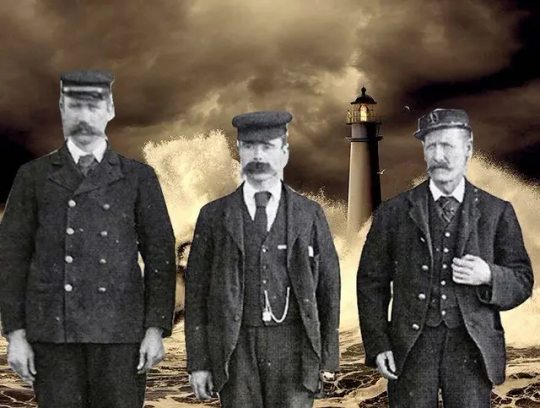
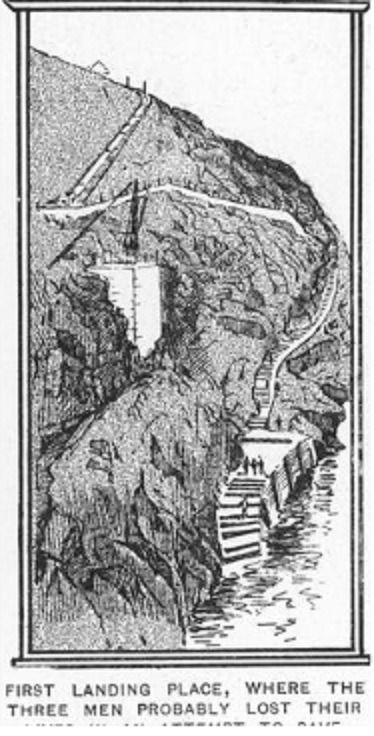

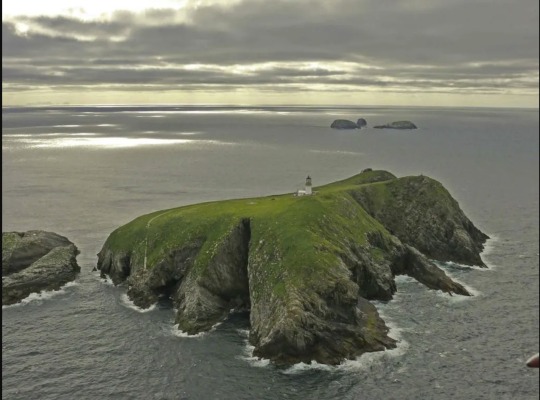
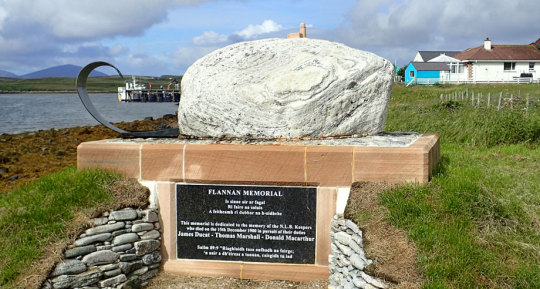
15th of December 1900 is the most likely date that the three lighthouse keepers of the year old Flannan Isles Lighthouse disappeared.
The building of Flannan Lighthouse was plagued with accidents, several workers died or vanished while working on the lighthouse, it took about 4 years to complete. Legend has it the island was said to be inhabited by mysterious “little people.” Large birds also were said to live there, too, and have contact with these little people.
Na h-Eileanan Flannach is the Scottish Gaelic name of the small group of islands known in English as the Flannan Isles. They are a bird sanctuary and at times a place of beauty. At others these remote islands bear the brunt of severe Atlantic storms, which whip the seas into frenzy and force even the hardy gulls to stay sheltered in the cliff face crags. For many years they have remained uninhabited, the last residents of any length being the lighthouse keepers, who between 1899 and its automation in 1971, kept the light burning on the highest point of the island group, Eilean Mòr.
On the island of Eilean Mòr is the ruin of an old chapel dedicated to St Flannan. However, over many centuries for many of the Gaelic Hebridean community the islands have been viewed as a place of superstition and bad luck. A view that was reinforced by the tragic and mysterious events that befell the lighthouse keepers on Eilean Mòr in mid-December 1900.
It is the fate of the lighthouse keepers, James Ducat, Thomas Marshall, and Donald McArthur, in 1900; just over one year after the island’s lighthouse came into operation that is the cause of much mystery and speculation. For all three keepers disappeared without trace. It was on 15th December 1900 that the ship Archtor which was sailing for Scotland from Philadelphia had reported that as they passed the islands the lighthouse was not in operation. In those days there was no radio communication between the keepers on Eilean Mòr and the shore station of Breasclete on Lewis.
When the lighthouse tender arrived on 26th December 1900 having been delayed due to adverse conditions.
There was no welcome from the lighthouse keepers, no flag on the flagstaff and no provision boxes left for them as was customary.
The relief keeper Joseph Moore was sent to investigate further and found the main door and gate to the compound closed, the beds unmade and the clock stopped. They also found a set of oilskins, suggesting one of the keepers to have left without them – unusual and worrying considering the poor weather conditions that had been recorded in the log.
The island was scoured for clues, or any sign of the keepers, but nothing was found. The west landing had received considerable damage, with turf ripped up and a box of supplies destroyed, with its contents strewn about. The keepers log proved that this damage had occurred before the disappearance.
The log leading up to the men’s disappearance included some strange entries, with descriptions of an awful storm, high winds, and low spirits amongst the keepers. There were however no reports of storms in the area in the days leading up to the disappearance, meaning that the poor weather conditions recorded in the log were either made up, or localised.
To this day no one knows what took place in the lighthouse that night, but many theories have developed over the years.
The more far-fetched of these theories suggest they had been carried away by a giant seabird, had been abducted by spies or had simply escaped to start new lives. The perhaps more plausible theories suggest that the keepers had been swept away when trying to secure a box in a crevice above sea level. Other theories suggest the psychology of the lighthouse keepers played a part. MacArthur had a reputation for brawling and was known to be violent. It is suggested by some that a fight broke out on the cliff edge, causing the men to fall to their deaths.
It was only after 1912, when English poet Wilfrid Wilson Gibson published his epic, Flannan Isle, that the story began to assume such an air of mystery, speculation, even intrigue. In general for lighthouse keepers themselves, there is no mystery and never has been, my uncle worked for the Lighthouse Board, and he says it was a freak wave that swept the men to their deaths, this is the assumption of many who worked the Islands around Scotland, but in truth we will never know what happened.
Flannan Lighthouse Memorial at Breasclete, Isle of Lewis , as seen in the pics, was unveiled in 2017.
34 notes
·
View notes
Text
It's Fallen London's birthday!!
Fifteen years of weird browser game!! I'm honor of this momentous occasion I am going to yap about my OCs.
I have two real ones (one of whom is actually a captain from Sunless Seas, but I'm bonking them together like dolls anyway so they go together), namely Their Inestimable Ladyship, Edna Ethne Vyner (Eddi to their friends) and The Steely-Eyed Captain, Lt. Augustine Moore.
Their Inestimable Ladyship is based on my actual progress in Fallen London, which is not as comprehensive as I'd prefer because I keep getting distracted because I love the story but I hate grinding to get where I want to be. That being said, Their Ladyship is a poet and a bohemian who has risen to considerable status at court and is in the process of establishing credit with the university. She's primarily persuasive and watchful, secondarily shadowy and dangerous, but eminently respectable and a bit bizarre. Eccentrics are often involved with the arts, you know. They have a host of admirers and acquaintances but vanishingly few friends among the peerage. Many consider them a romantically lonely figure, so accomplished as to be distant from the somebodies who are somebody. This couldn't be farther from the truth. The issue is that their real friends tend to be urchins and dockhands and rattus faber and dance hall singers and other such unmentionables, and they wouldn't dream of exposing the people they care about to the carping and fault-finding of society.
The Steely-Eyed Captain is from my most successful run of Sunless Seas, a guy who sets out to find his father's bones and gives that up in pursuit of immortality for everyone. He was a lieutenant in the campaign of '68, after which he swore never to fight a devil again, and especially not on its home turf. Perhaps predictably, he's focused on iron. Somewhat unexpectedly, he's also very high on pages. In descending order from there: mirrors, hearts, veils. Not a terribly subtle guy, but quite clever and very perceptive. He's one for taking big gambles, but only when he can see the possibility of success. He likes his crew and they respect him, though he doesn't get involved with their lives most of the time. The officers are a bit different, but even there he keeps a certain distance. In his avoidance of entanglements romantic or otherwise, he's made an exception for the Pirate Poet and for Their Inestimable Ladyship. He is absolutely smitten with Eddi from first sight.
4 notes
·
View notes